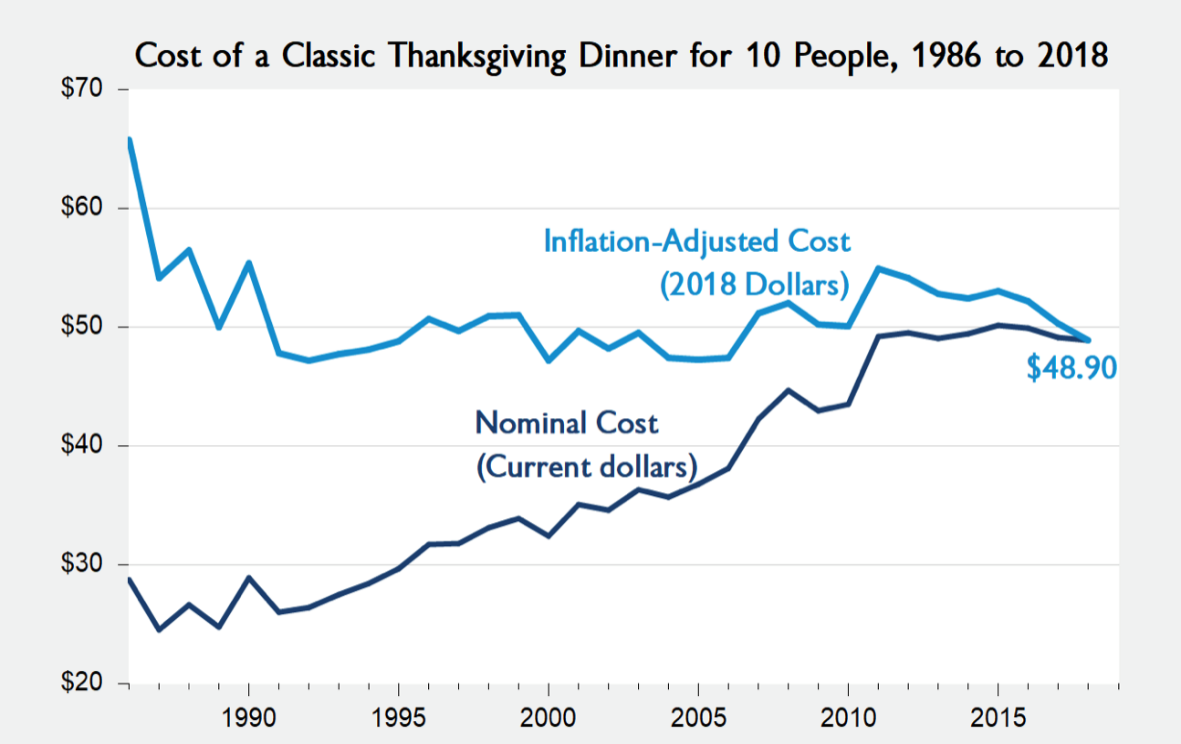The cost of the Thanksgiving in in inflation adjusted real terms is $19.37 this year, down 2.7% from a year ago and equivalent to the lowest price since 2010. In real terms, the cost of a Thanksgiving dinner in 1986 would have been $65.73 (in 2018 dollars), which translates into a Thanksgiving dinner that is 25.6% cheaper than it was 32 years ago!

Source: American Farm Bureau, AEI
-
- The average US production worker earns $22.89 per hour according to the Bureau of Labor Statistics. That hourly wage would suggest that it would take 2.14 hours of work to afford a classic Thanksgiving Dinner for 10 people ($48.90/$22.89 = 2.14 hours). That result is 3.2% lower in terms of hours worked versus last year when it would have taken 2.21 hours ($49.12 in total cost divided by the hourly wage of $22.18 in October 2017).
- The cost of a Thanksgiving Dinner took 3.21 hours of work in 1986. Thus, today’s family can afford the same classic Thanksgiving Dinner experience while working 2.14 hours, or 33% less than what it cost the 1986. Clearly the American worker has benefitted from productivity in the food area.
Additional Interesting Facts About the Thanksgiving Holiday
- The turkey is truly America’s bird as fossil evidence indicates that turkeys roamed the Americas over 10 million years ago
- Ben Franklin wanted the turkey to be our National Bird. He felt the Eagle had “bad moral character” as a hunter/killer while the turkey was a much a more respectable bird.
- According to the National Turkey Federation, over 95% of Americans eat turkey on Thanksgiving.
- According to the National Turkey Federation, about 51.6 million turkeys were eaten on Thanksgiving Day in 2017 compared to 22 million turkeys eaten at Christmas and 19 million eaten on Easter Sunday. While these sound like huge numbers, they are much less than they used to be
- In 2017, about $2.983 billion was spent on the entire dinners in the United States. The amount included side dishes that were eaten along with the turkey. Those dishes included mashed potatoes, green bean casserole, and candied yams. About 3.1 billion pounds of sweet potatoes were served
- Only 29 percent of the 244.5 million turkeys raised on farms in 2017 were actually killed and eaten.
- The average turkey purchased for Thanksgiving weighs 16 pounds according to the National Turkey Federation. White meat makes up 70% of a turkey, with dark meat making up the other 30%.
- Each year, the average American eats somewhere between 16 and 18 pounds of turkey.
- The average time cooking the Thanksgiving dinner is 7 hours. The average time to eat the Thanksgiving dinner is only 16 minutes
- The average number of calories consumed on Thanksgiving is around 4500. The time it takes the average male to burn 4500 calories is between 8 and 10 hours. By contrast, the original celebrants of the first Thanksgiving consumed around 550 calories mostly because of a lack of pies and alcohol
- About 70 percent of Americans think it is not a real Thanksgiving dinner without a turkey even though the bird was not on the menu of the first Thanksgiving dinner. The pilgrims and Indians ate deer, duck, geese, oysters, lobster, eel, and fish.
- Approximately 859 million pounds of cranberries are produced each year, and Thanksgiving is responsible for about 20 percent of those sales. Originally called crane berry, it derived its name from its pink blossoms and drooping head, which reminded the Pilgrims of a crane. Cranberries are one of only three fruits that are native to North America. Native Americans were the first to reap the many benefits of cranberries. Aside from eating cranberries, Native Americans used the red juice from cranberries a dye for clothing, rugs, and blankets. They also used cranberries as a medicine to treat ailments and to treat arrow wounds. Native Americans believed in the medicinal use of cranberries long before scientists discovered their health benefits. Today, cranberries are an essential side dish to our Thanksgiving feast.
- It is erroneously believed that the tryptophan in is responsible for Thanksgiving “food comas.” Instead, it’s eating a high calorie meal and drinking alcohol that makes people sleepy. Tryptophan is higher in chicken than turkey.
- AAA projects 54.3 million Americans will journey 50 miles or more away from home this Thanksgiving, a 4.8 percent increase over last year. The 2018 holiday weekend will see the highest Thanksgiving travel volume in more than a dozen years (since 2005), with 2.5 million more people taking to the nation’s roads, skies, rails and waterways compared with last year.
- 64% of Americans plan to drink wine with their Thanksgiving meal; 47% beer; 37% liquor-based cocktails; 17% malt flavored beverages; and 15% hard cider
- The wishbone of the turkey is used in a good luck tradition on Thanksgiving. This tradition dates back to the Etruscans of 322 B.C. The Romans brought the tradition with them when they conquered England, and the English colonists then proceeded to carry the tradition to America.
- Turkey is listed among the top 10 foods for your eyes because it’s rich in zinc (plus the B-vitamin niacin protects against cataracts).
- Turkey was the first meal enjoyed by Neil Armstrong and Buzz Aldrin when they were on the moon.
- Companies involved in the production and processing of turkey provide 374,600 jobs that pay $21.4 billion in wages to families throughout the country, generate about $97.5 billion in annual economic impact, and about $7.5 billion in taxes.
J. Richard Fredericks is founding partner at Main Management, a participant in the ETF Strategist Channel. For the extended version of this article, please inquire at [email protected].
A pioneer in managing all-ETF portfolios, Main Management LLC is committed to delivering liquid, transparent and cost-effective investment solutions. By combining asset allocation insights with smart implementation vehicles, Main Management offers a unique approach that translates into distinct advantages for our clients, including diversification, cost efficiency, tax awareness and transparency. For more information, visit http://www.mainmgt.com.

